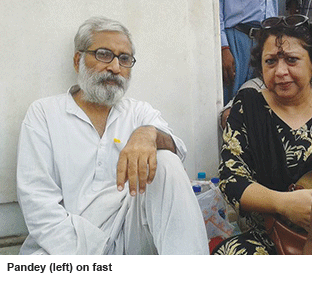Uttar Pradesh: Puzzling laxity
 A seven-day protest fast by magsaysay award winner (2002) Sandeep Pandey against Lucknow’s top-ranked City Montessori School (CMS) over its refusal to admit children from economically weaker sections (EWS) under s.12 (1) (c) of the controversial Right of Children to Free and Compulsory Education Act, 2009 (aka RTE Act), has created a major stir in the city.
A seven-day protest fast by magsaysay award winner (2002) Sandeep Pandey against Lucknow’s top-ranked City Montessori School (CMS) over its refusal to admit children from economically weaker sections (EWS) under s.12 (1) (c) of the controversial Right of Children to Free and Compulsory Education Act, 2009 (aka RTE Act), has created a major stir in the city.
Pandey began his fast against CMS — ranked #1 in Lucknow and Uttar Pradesh (pop.200 million) in the co-ed day schools category in the EducationWorld India School Rankings 2014, and also listed in the Guinness Book of Records as the world’s largest (20 campuses, 29,200 students) single-city school — on July 10. According to him, CMS refused to admit 31 students from economically disadvantaged backgrounds (as stipulated by s.12 (1) (c)), even though it was directed by the basic education officer (BEO) to do so, pleading that it doesn’t have space on the Indiranagar campus, to which the BEO’s order applied.
CMS is not a stray case. According to data available with the state’s primary education department, of the state’s 75 districts, 54 had not recorded a single admission of EWS children under s.12 (1) (c), which makes it mandatory for all private (except boarding and certified minority) schools to reserve a 25 percent quota in class I for children from EWS households in their neighbourhoods. Private schools in the state’s capital Lucknow admitted only 467 EWS students, while private schools in Faizabad district admitted 1,435.
“Despite the clear mandate of the RTE Act, and the Supreme Court having upheld the validity of s.12 (1)(c) for all except minority schools, admitting poor children has become an act of benevolence, not a matter of right. Whenever we try to reason with such schools, their powerful alumni associations spring to their defence,” says Juhie Singh, chairperson of the state’s Commission for Protection of Child Rights.
Official and general response to the landmark RTE Act, which makes it mandatory for the State (Central, state and/or local governments) to provide free and compulsory education to all children in the 6-14 age group, has been lukewarm ab initio in UP — among India’s most backward states and listed #35 on NUEPA’s Educational Development Index, 2014. Although the Act became operational on April 1, 2010 countrywide, the state government notified it only in 2011. Thereafter, few of UP’s 66,983 private unaided schools have bothered to implement s.12 (1) (c), and education ministry officials tend to look the other way. Schools which admit poor children from their neighbourhoods often relegate them to ‘special classes’ held after regular school hours with part-time teachers.
Nor is the state government, which has the prime responsibility to ensure all schools meet the infrastructure and teacher-pupil ratio (1:40) norms mandated by s.19 of the RTE Act, bothered about this provision of the Act. For instance, only 43.7 percent of the state’s government schools have functional toilets for girls, and a mere 58.5 percent have boundary walls despite a three-year time window (which closed in 2013) given by the Act for all schools (including government schools) to comply with s.19.
Pandey’s protest fast, which attracted wide support from civil society organisations and the public and was emulated in eight district headquarters statewide, was called off on July 17 after the Lucknow bench of the Allahabad high court ordered government officials to visit the CMS Indiranagar campus to ascertain the veracity of the school’s claim that it has no space, and cannot shoulder the extra monetary burden that will fall upon it if EWS children are admitted into either of the two shifts the school runs.
Undoubtedly, there’s some merit in the argument that the State should focus its attention on improving government schools instead of passing off its obligation to private unaided (financially independent) schools. But this argument was made before the Supreme Court in the Association of Unaided Schools of Rajasthan vs. Union of India (2013) and rejected (minority schools exempted). In the circumstances, the laxity of the Samajwadi Party state government and high court to rigorously enforce s.12 (1) (c) has puzzled educationists, outraged social activists and perplexed the public in India’s most populous state.
Puja Awasthi (Lucknow)














Add comment